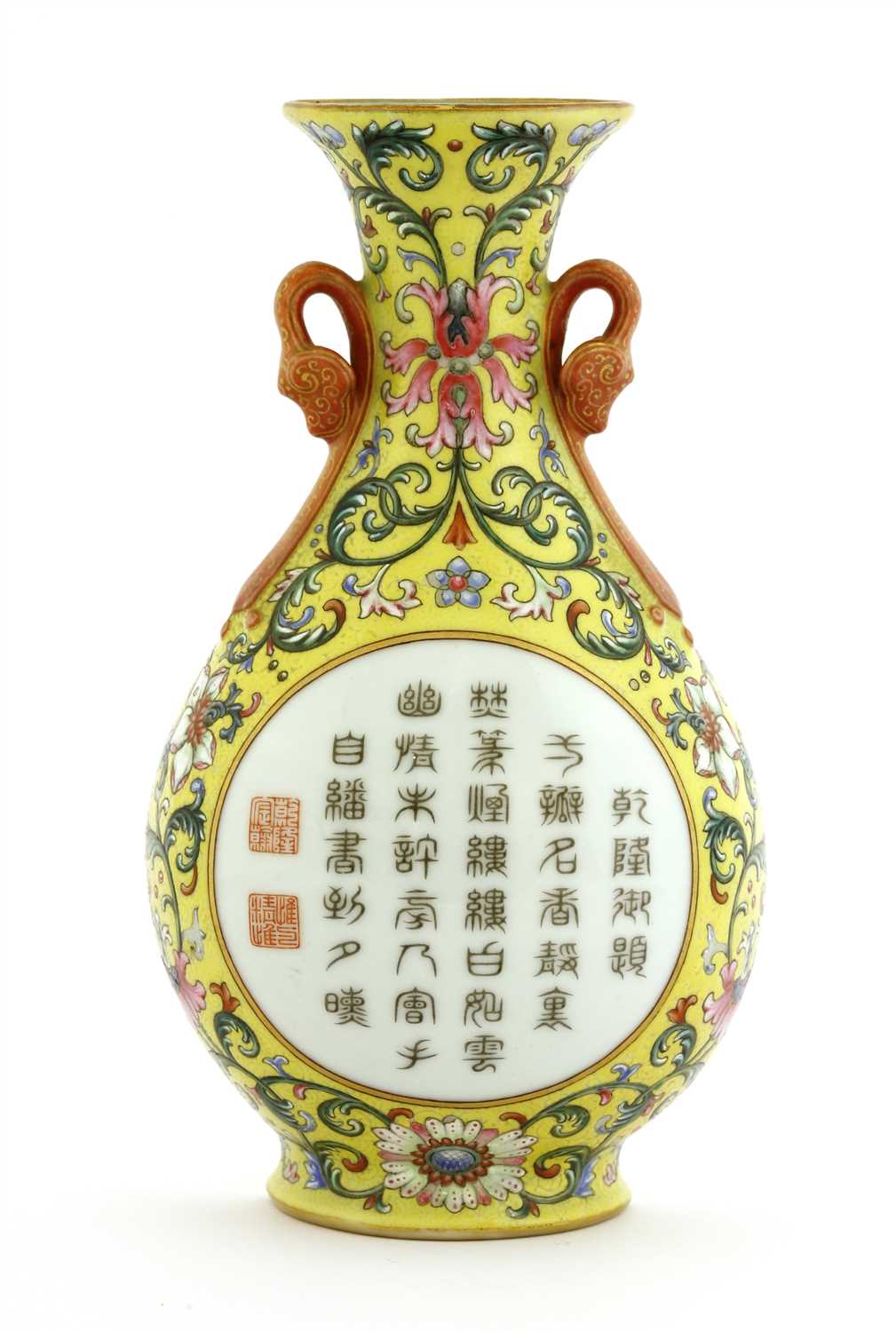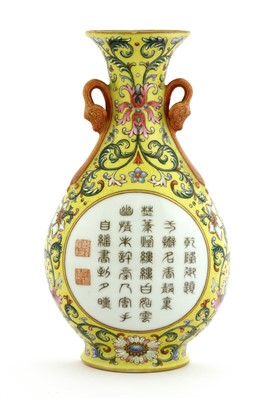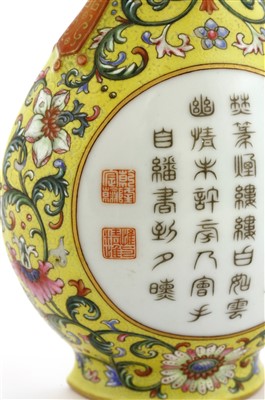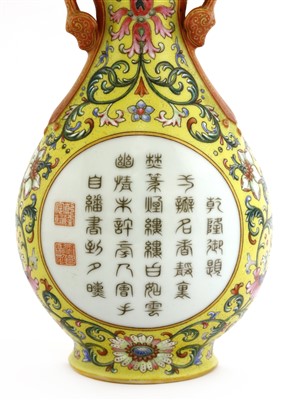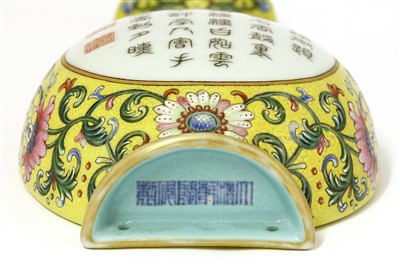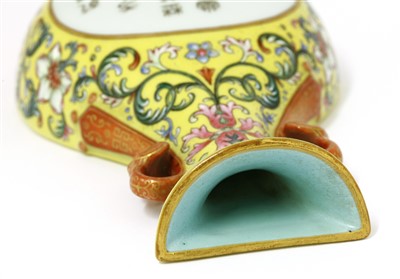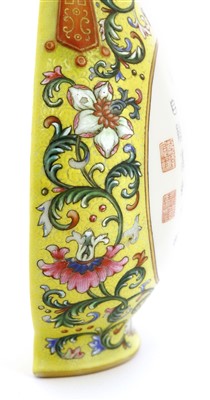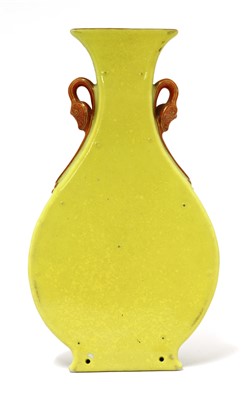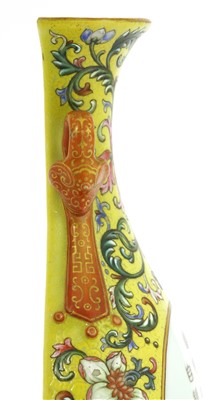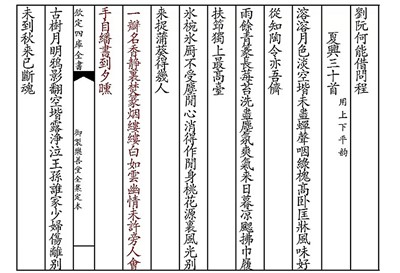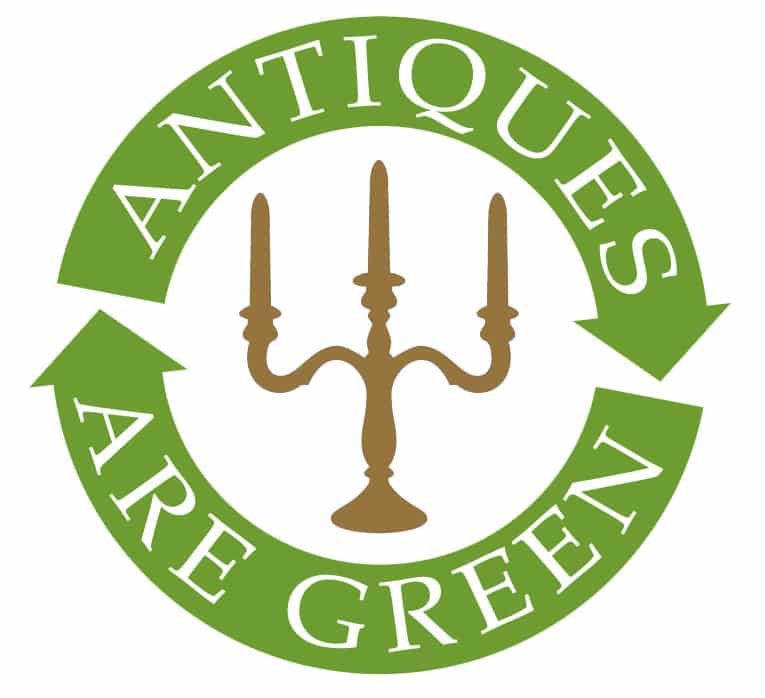8th Nov, 2019 16:00
Asian Art - Two Day Sale (Day One)
81
A Chinese imperial inscribed famille rose wall vase
A Chinese imperial inscribed famille rose wall vase,
Qianlong (1736-1795), well modelled and flattened at the back, the pear-shaped form on a short splayed foot, flanked by a pair of ruyi handles to the waisted neck, the body inscribed with an imperial poem appraising incense in a circular cartouche with a yuti mark followed by two iron-red seal marks reading Qianlong chen han (the Qianlong Emperor's own mark) and Weijing weiyi (be precise, be undivided), surrounded by scrolling lotus against a yellow sgraffito ground,
19cm high
The poem is recorded in the Yuzhi leshantang quanji dingben [Definitive Edition of the Complete Works by His Majesty from the Hall of Pleasure in Goodness], Siku quanshu [The complete library in four sections] ed., vol. 30.
清乾隆 黄地轧道洋彩如意耳开光御题诗纹壁瓶
《乾隆辰翰》《惟精惟一》矾红篆书款
《大清乾隆年制》青花篆书款
诗题:一瓣名香静里焚,篆烟缕缕白如云。幽情未许旁人㑹,手自翻书到夕曛。
Wall vases, also known as wall pockets or sedan chair vases, can be traced back to the Wanli period (1573–1620) in the Ming dynasty, when examples can be found for flower displays on the wall. During the 18th century under the reign of the Qianlong Emperor (1735-1796), government support for arts and craftsmanship reached its peak, the quality of the refined material and the artistic innovation all representative of the emperor’s ambition. Wall vases, of all porcelain forms, became one of Qianlong’s favourite types and developed significantly during his reign. There are thirteen wall vases in varying glazes and forms on the wall of San Xi Tang (The Hall of Three Rarities), the emperor’s special study in Yang Xin Dian (Hall of Mental Cultivation) in the Forbidden City, where he housed his most prized possession: the calligraphic works comprising ‘Timely Clearing After Snowfall’ by Wang Xizhi, ‘Mid-Autumn’ by Wang Xianzhi and ‘Boyuan’ by Wang Xun (fig.1).
There are 320 Qianlong wall vases recorded in the collection of the Palace Museum in Beijing and about 138 of them are inscribed with poems by the emperor. Only a few of these poems are from Yuzhi Leshan Tang quanji [The complete Works by His Majesty from the Hall of Pleasure in Goodness], which were written by him as Heshuo Bao Qinwang (Prince Bao of the First Rank), his title from 1722 to his accession in 1735, and which were first printed in 1737 (fig.2). According to Zaoban Chu Gezuo Chengzuo Huoji Qingdang [The Archives of the Imperial Workshops], on the 23rd of September in the 7th year of the Qianlong period (1742), the emperor specifically commissioned Tang Ying (1682-1756) to produce porcelains with selected poems from Leshan Tang quanji. And on the 16th of October in the 17th year (1752), the emperor instructed Tang Ying that instead of the poems from the Leshan Tang quanji, which were written when he was still a prince, only poems composed after his accession in 1735 should be used (see Chi Jo-hsin, 'cong wenwu kan Qianlong huangdi [understanding Qianlong Emperor through artifacts]', Emperor Ch’ien-lung’s Grand Cultural Enterprise, National Palace Museum, Taipei, 2002, p. 233). In view of this the present wall vase must have been produced between 1742 and 1752, as part of a larger order which included the pair of vases in the collection of the Palace Museum: all three are identical but for their differing poems; see Poem and Porcelain: The Yu Zhi Shi Ceramics in the Palace Museum, Beijing, 2016, pl. 46 (fig.3).
Enhancing the rarity of the present lot, is its yangcai (foreign colours) decoration, which was introduced by European Jesuit craftsmen to the Qing court around 1685, adapting the European techniques of enamelling on metal. This resulted not only in an enriched palette of colours, but also in a combination of European brocade-like designs, using tonal effects to appear three-dimensional, and purely Chinese elements such as scrolling lotus motifs. Developed in the Jingdezhen imperial workshops under the patronage of the Qianlong Emperor, this style is representative of the superb quality of porcelain production achieved during the Qianlong reign. Special orders of yangcai are believed to date from only a few years in the early 1740s, with none after Tang Ying’s death in 1756. For more examples of yangcai enamels on sgraffito grounds, see Huali cai ci: Qianlong yangcai/Stunning Decorative Porcelains from the Ch’ien-lung Reign, National Palace Museum, Taipei, 2008.
NO ONLINE BIDDING ON THIS LOT. PLEASE CONTACT US TO ARRANGE TELEPHONE BIDDING.
此件拍品不参与网络竞投,请直接联系我们咨询竞投方式
Take advantage of our Sworders Delivery Service. Please see 'Shipping estimate' below.
Sold for £380,000
Condition Report
Enamel losses and flakes in numerous places, gilt rubbed, a small chip to one handle.
IN PERSON
To bid in person at auction for the first time please register for a bidding paddle in advance by filling out and submitting a registration form at our front desk. When registering in person we require photo ID, such as a passport or driving licence.
ABSENTEE BIDDING
If you cannot attend the auction in person we can bid on your behalf. You can leave an absentee bid on our website.
The amount you bid should be your maximum bid. We will bid up to that limit for you, and remember you may end up paying less than your limit, depending on other bidding on the day.
You can leave an absentee bid up to half an hour before the start of any sale. Please note when we receive two or more absentee bids for the same amount, the first bid received will be the one taken.
LEAVE COMMISSION BIDS ONLINE
If you would like to leave a commission bid on our website you can do so up until 30 minutes before the sale starts. Leaving a commission bid through sworder.co.uk is free for all registered clients. Thereafter you may register bank card details under your account in order to bid live. Click here to register an account.
BID LIVE ON sworder.co.uk
You can bid live at our auctions from the comfort of your home or office using bidding platform Sworders Live. It is easy to register and you can watch the auction live as it happens. A 'Bid Live' button will appear on the auction on our website homepage when a sale is live; simply click the button to sign in or register with your card details. There is no additional charge for this service.
For further instructions on registering to bid live, please click here.
TELEPHONE BIDDING
If you would like to bid by telephone please contact our team prior to the auction with your details of the lots you are interested in and your full name, address, telephone number(s) and email address. Once our team have entered your bid request you will receive an email confirmation. We will contact you during the sale and one of our team will bid live with you over the phone.
Please note that we normally offer this service for lots with an estimate of £500 or higher and all telephone bid requests must be received by close of business the day before the auction.
Auction: Asian Art - Two Day Sale (Day One), 8th Nov, 2019
Viewing
to be held at
15 Cecil Court, London WC2N 4EZ
Sun 3 Nov 2019, 10.30am - 5pm
Mon 4 Nov 2019, 10.30am - 5pm
Tues 5 Nov 2019, 10.30am - 5pm
Weds 6 Nov, 10.30am - 5pm
Thurs 7 Nov, 10.30am - 7pm
Fri 8 Nov, from 10.30am
AUCTION TO BE HELD AT THE MOUNT VERNON ROOM, THE WESTBURY, MAYFAIR W1S 2YF
Sorry, we cannot calculate a pre-sale automated shipping cost due to the items weight/size.
Should you be successful in buying this item, a specific shipping estimate can be requested after the sale by using the link in your invoice email; this also includes requests for international delivery.
If you would like further information about shipping and collection please see here.
Buying a pre-loved, antique, or vintage item not only provides you with unique style and value for money but it also helps to reduce landfill, and the annual emissions of an antique or vintage piece can be as little as one sixteenth of those of its new equivalent!
Sworders is proud to be supporting the work of Antiques are Green - the movement that was founded in 2009 to promote “a greener future created from the past”. Read their fascinating carbon footprint study of a Georgian chest of drawers versus a modern equivalent here
Request A Valuation
Here at Sworders, we are happy to offer a free online valuation service. Please fill out the form and press the 'Submit' button below.
To help us with your valuation please attach clear photographs of the item where possible. You can submit up to 5.
Approximate dimensions are also useful. Expect to hear from the appropriate valuer as soon as possible.
